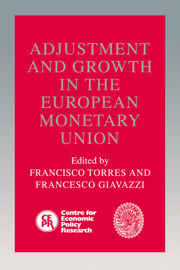Book contents
- Frontmatter
- Contents
- List of figures
- List of tables
- Preface
- List of contributors
- Foreword
- 1 Introduction
- 2 Economic and monetary union: critical notes on the Maastricht Treaty revisions
- Discussion
- 3 The design of optimal fiscal rules for Europe after 1992
- Discussion
- 4 Contracts, credibility and common knowledge: their influence on inflation convergence
- Discussion
- 5 Inflation in fixed exchange regimes: the recent Portuguese experience
- Discussion
- 6 Models of economic integration and localized growth
- Discussion
- 7 Shocking aspects of European monetary integration
- Discussion
- 8 Lessons of Massachusetts for EMU
- Discussion
- 9 Financial and currency integration in the European monetary system: the statistical record
- Discussion
- 10 Currency substitution: from the policy questions to the theory and back
- Discussion
- 11 Coordination of capital income taxes in the economic and monetary union: what needs to be done?
- Discussion
- Index
Discussion
Published online by Cambridge University Press: 29 January 2010
- Frontmatter
- Contents
- List of figures
- List of tables
- Preface
- List of contributors
- Foreword
- 1 Introduction
- 2 Economic and monetary union: critical notes on the Maastricht Treaty revisions
- Discussion
- 3 The design of optimal fiscal rules for Europe after 1992
- Discussion
- 4 Contracts, credibility and common knowledge: their influence on inflation convergence
- Discussion
- 5 Inflation in fixed exchange regimes: the recent Portuguese experience
- Discussion
- 6 Models of economic integration and localized growth
- Discussion
- 7 Shocking aspects of European monetary integration
- Discussion
- 8 Lessons of Massachusetts for EMU
- Discussion
- 9 Financial and currency integration in the European monetary system: the statistical record
- Discussion
- 10 Currency substitution: from the policy questions to the theory and back
- Discussion
- 11 Coordination of capital income taxes in the economic and monetary union: what needs to be done?
- Discussion
- Index
Summary
Miller and Sutherland focus on the case where a new exchange rate arrangement implies a significant reduction in the rate of currency depreciation and inflation. The more familiar models developed in their chapter suggest that the costs of such a reform depend upon the credibility of the new exchange rate regime, the inertia in wage setting behaviour, and the level chosen for the nominal exchange rate at the time of the reform. A novel aspect of the chapter is that uncertainty about the beliefs of other private wage setters can make individuals who believe the regime change to be credible behave as if the new regime is not fully credible.
The chapter makes several contributions to our understanding of the issues. First, overlapping wage contracts and inertia are not a potent source of inflationary pressure following the reform. To see this it is useful to modify slightly the figure used in their chapter. Figure D.4.8 shows the price level and the level of the nominal exchange rate. Prior to the reform, the level of these two variables had moved together for a long time so that the real exchange rate was constant. At the origin, the exchange rate is fixed but the price level for one or more of the reasons listed above continues along its former trajectory for a time. Clearly the real exchange rate remains above its long run equilibrium until the price level falls back to the P = 0 axis.
- Type
- Chapter
- Information
- Adjustment and Growth in the European Monetary Union , pp. 123 - 127Publisher: Cambridge University PressPrint publication year: 1993



